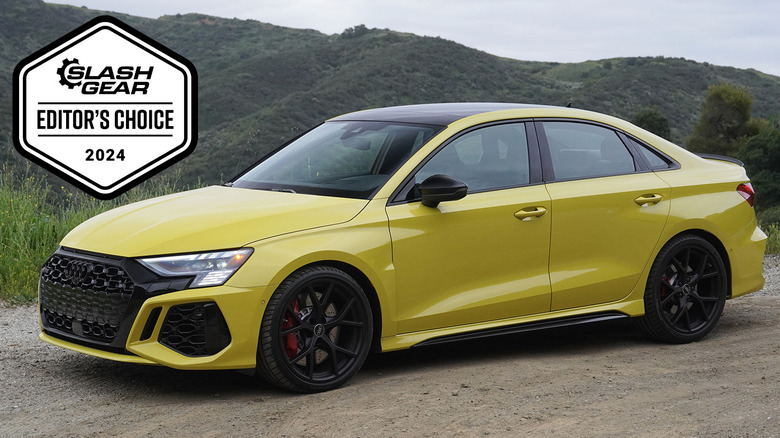
Michael Teo Van Runkle/SlashGear
EDITORS’ RATING : 9 / 10
- Barking 2.5-liter inline-five harkens back to the original Quattro
- Trick rear differential helps tame inherent understeer
- Drift mode!
- Crisp, clean interior with simple, functional tech
- Definitely not in this shade of yellow
- Pricing still adds up quick
- No manual transmission offered
Once upon a time, in the years when I worked a dreary office job before committing to the nonstop international sleep deprivation experiment of automotive journalism, I bought a car brand-spankin’-new from the dealership. At the time, spending $36,000 or so on a 2016 Audi A3 2.0T Quattro seemed entirely reasonable. After all, I had a steady paycheck, plenty of vacation days for ski trips, and another manual sports car to play with on the weekends.
But where the base A3 2.0T fit into my budget, I always wondered about the much more expensive and desirable RS3. That barking five-cylinder engine, harkening back to the earliest days of Quattro rally dominance, seemed perfect to shoehorn into the compact four-door chassis. As I got to know the A3 better, the prospect only sounded more appealing, too, because — as peppy as the little turbo-four and Haldex-based AWD drove — the car simply begged for a whole lot more power.
This spring in Los Angeles, that erstwhile suspicion finally came to fruition when Audi loaned me a 2024 RS3 for a week of daily driving, highway commuting, and canyon carving. And unfortunately, I can now confirm that I should’ve bought an RS3 when I had the time and money to do so—though in reality, the new RS3’s technology, introduced steadily over the years since I bought my A3 in 2016, takes the concept of rally heritage and daily drivability in a compact sport sedan to a whole new level.
Looking good, but not in this yellow
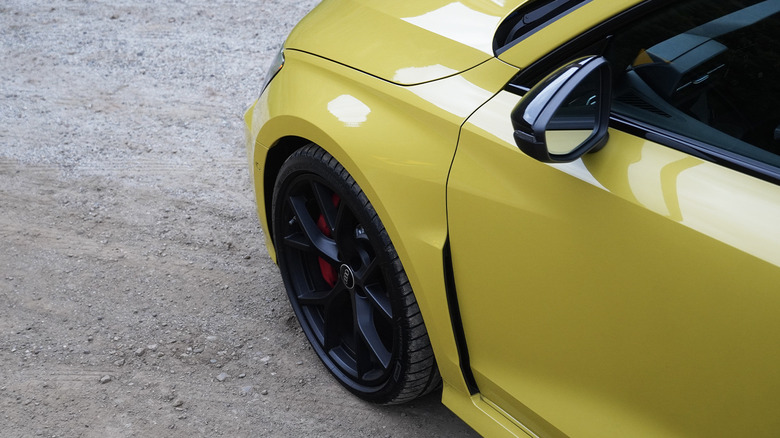
Michael Teo Van Runkle/SlashGear
My biggest complaint about the RS3 reveals just how much I loved the car. Namely, that disgusting, yet somehow increasingly popular, shade of simultaneously bright and dark yellow paint that most journalists semi-lovingly refer to as «baby vomit.» You might see a similar color on a Chevy Colorado or Toyota Tacoma, but on the RS3 the unfortunate tone underserves the overall design. A black, dark silver, or grey might better hide the large glossy front grille and fake aero inlets, while emphasizing the muscular fender flares that create a wider, lower, more aggressive stance than on lower-spec A3 and S3 variants.
And that stance plays out in real life, without question on an entirely different level of performance than my old A3. Don’t get me wrong, though, I loved the A3 and put over 40,000 miles on the odometer in just over two years of ownership. The front-biased Haldex system made it, beyond a doubt, the best snow car I’ve ever driven (even on just the factory Pirelli all-seasons) and the snappy DCT helped to harness what most owners suspect must have been a massively underestimated 258 lb-ft of torque from the turbo 2.0-liter.
Reminiscing about old times with Audis
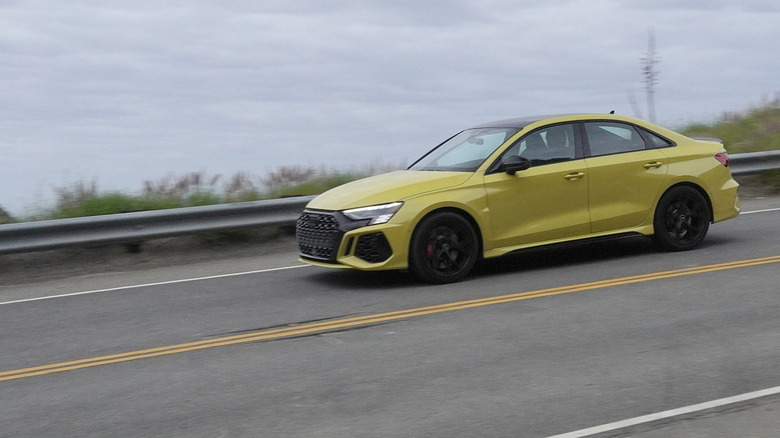
Michael Teo Van Runkle/SlashGear
I commuted in the A3, but also spent plenty of time in the canyons when my manual car refused to start—more on that momentarily. While pushing hard, the nose-heavy Audi engineering shone through clearly, revealed by shudders of understeer that demonstrate what happens when you mount an engine entirely ahead of the front axles. Of course, when the Haldex system noticed and started to route torque rearward, the sensation faded a bit, but the whole nose still seemed to pull through tight corners rather than leaning and hooking up the outside tires.
The A3 drove relatively similar to my manual sports car, actually: a 2001 Audi TT Quattro with the 225-horsepower inline-four and six-speed stick shift. A decade and a half of refinement between the two helped Audi keep the overall weights relatively similar, despite the A3’s heavier dual-clutch transmission and four-door layout. And gearing probably made up for some of the difference in power output, since I will admit to hopping up the TT’s inline-four with a Stage 1 REVO tune that prioritized air-fuel ratios for low-end tractability and a wider torque band (while also simultaneously improving my fuel economy, somehow).
Dreaming of a classic Audi
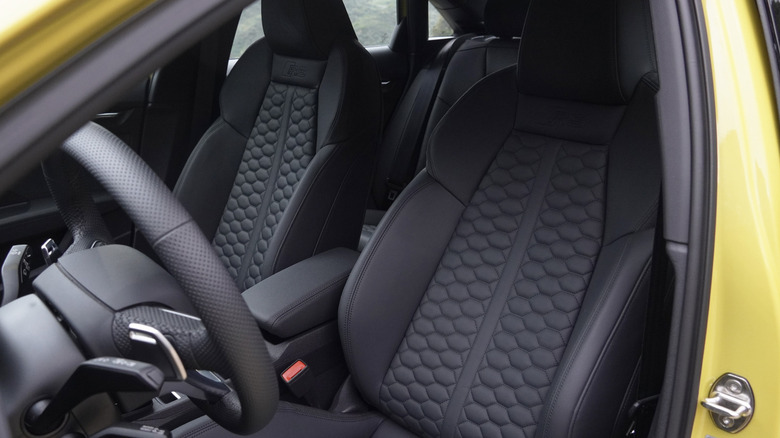
Michael Teo Van Runkle/SlashGear
My TT also benefitted greatly from slightly firmer-than-OEM Bilstein dampers, an uprated rear sway bar from H&R, and Michelin all-season tires. As much as the boost build-up improved from the REVO tune, the biggest single improvement came from the sway bar, which helped to reduce understeer far more than I ever expected, or indeed hoped for.
With the car dialed in, I learned to brake earlier before corner entry and then accelerate through curves in rally racing fashion. I loved that TT, and always fantasized about lifting it with mud flaps and installing a Haldex controller to lock torque split at 50: 50 front to rear. But of course, a 2001 Audi with 140,000 miles on the clock slowly started eating me out of house and home—even with the steady income of an office job—so eventually, I sold both cars in late-2019.
Turbo inline-five ratchets up the power
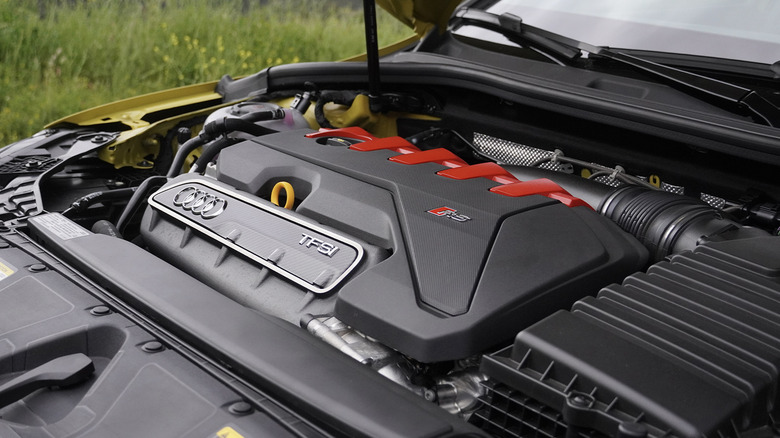
Michael Teo Van Runkle/SlashGear
Almost five years later, I still think about a rally-prepped TT on the regular. So, when the RS3 arrived at my door, I headed straight up to the canyons to remind myself of that long-lost fantasy, though with a bit of curiosity starting to creep in about whether my years of driving the world’s greatest cars in the interim might make these simple little AWD commuters somewhat less exciting.
Guess again! First things first, pop into Sport mode and bring that unusual 2.5-liter turbocharged inline-five to life. Now putting down 401 horsepower and 369 lb-ft of torque—almost double my A3 2.0T’s output—the RS3 can rip off a 0-60 sprint in as little as 3.3 seconds. But then again, I figured, the larger engine contributes to a curb weight over 3,600 pounds, or about 10% more than my A3 or TT. How would even more mass over the nose perform with a front-biased all-wheel-drive system, on asphalt rather than being flung around gravel rally stages?
Everything you need, nothing you don’t
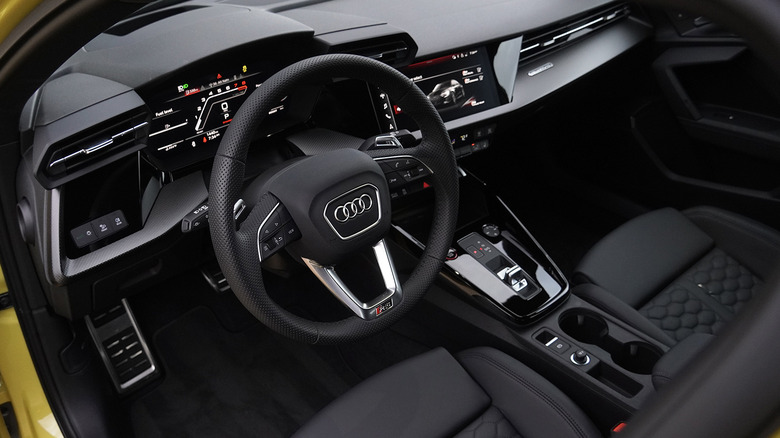
Michael Teo Van Runkle/SlashGear
First impressions of the RS3, other than in sheer performance metrics, definitely impressed. The interior design now emphasizes volume and comfort much more than the generation I grew accustomed to driving back then. A stark vision of luxury throughout helps that sensibility, with a minimalist center console and dash design right down to the mid-sized infotainment screen and reductive gear selector—the latter probably being my second biggest gripe.
Hey, we’ve got wireless Apple CarPlay at the very least. Welcome to the modern era! Hexagonal honeycomb quilted leather seats, carbon-fiber trim throughout, and a configurable gauge cluster that changes layouts depending on drive mode round out the amenities. One peculiar detail that stood out at first actually wound up on my list of pros: the extremely thin-rimmed, simple steering wheel with minimal buttons and dials as distraction.
I fiddled through the drive modes on the way out of town, hoping to figure out which combination I liked best before actually arriving to any winding roads. After some melodramatic pops and burbles at startup, both the Comfort and Auto modes prompted early shifts from the transmission to keep the engine quiet and sedate at low revs, with the suspension and steering quite tame, too.
Adjusting to the RS3’s performance
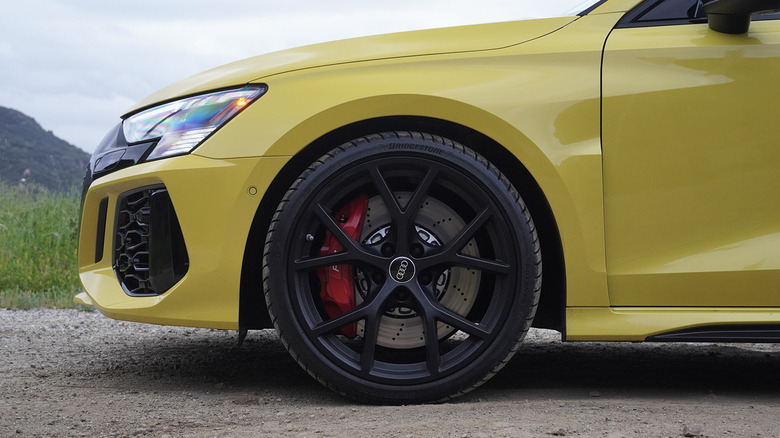
Michael Teo Van Runkle/SlashGear
The fact that Audi kept the RS3’s wheel and tire choice at a relatively conservative 19-inch diameter, and shod in 265-millimeter fronts with 245-millimeter rears, undoubtedly helps the suspension cope with some of the less ideal road surfaces between West LA and Malibu. And punching the throttle in either Comfort or Auto provided a bit of pizazz from the exhaust, though nothing that might overwhelm my neighbors’ patience.
Right away, I also noticed that familiar heft over the front axles, even before turning off the Pacific Coast Highway. Well, time to flip over into Dynamic and button down this beast. Sure enough, the turbo-five immediately roared to life, awoken from slumber and cranky, eager to breathe deeply of the cold Malibu canyon air. And my oh my, how well 401 horses and copious low-end torque pair to a seven-speed transmission and all-wheel drive.
Then I dropped into manual mode, though, and discovered that Audi surprisingly dropped the dual-clutch gearbox in favor of a traditional torque converter. Definitely the wrong move, and a huge bummer while using the paddle shifters, which I needed to pop a solid 1,500 to 2,000 RPMs before each upshift to prevent lurches at redline while running hard. Downshifting via the paddles worked a bit better, but I realized quickly why Audi made the RS3’s paddles so small—probably best to just leave the trans to shift for itself, and trust the turbo’s torque to make up the difference.
Torque throughout the RS3’s rev range makes driving fast easy
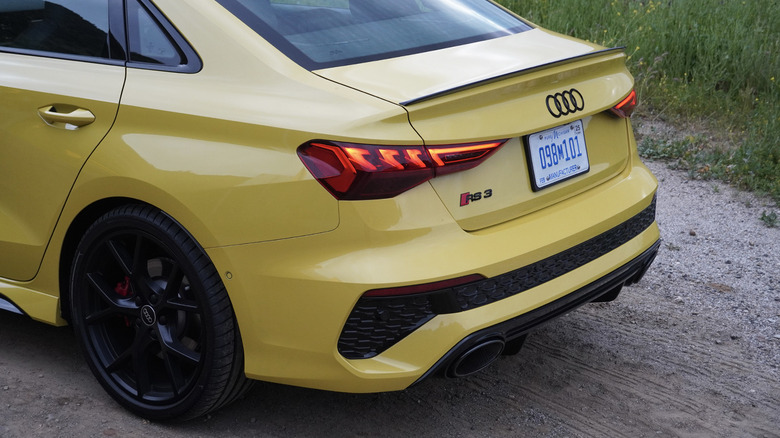
Michael Teo Van Runkle/SlashGear
It turns out, you don’t need to rev that five-cylinder mill anywhere near redline to coax or convince more power out. What a gem of a motor, paired to nice short gear ratios in classic rally car fashion. But still, while pushing hard I noticed that old sensation of the front wheels pulling through, some chattering of oversteer while braking hard, and only a hint of oversteer once I got the weight on the front legs and the rear tires lifting a bit.
Getting back on the gas caused a bit more understeer out of corners, even as Audi’s latest iteration of that old Haldex front-biased all-wheel-drive system attempted to route power rearward. But then I remembered the trick rear differential, with two clutches itself out back that allow for a kind of drift mode. Sure enough, I punched the RS button on the steering wheel and slowed down for a sec to finger into the RS Torque Rear settings on the touchscreen. A little page popped up to warn against doing so on public roads—yeah, okay—and then sure enough, with the ESC fully off, I discovered the RS3’s absolute magical wizardry.
Full-on rally racing fun
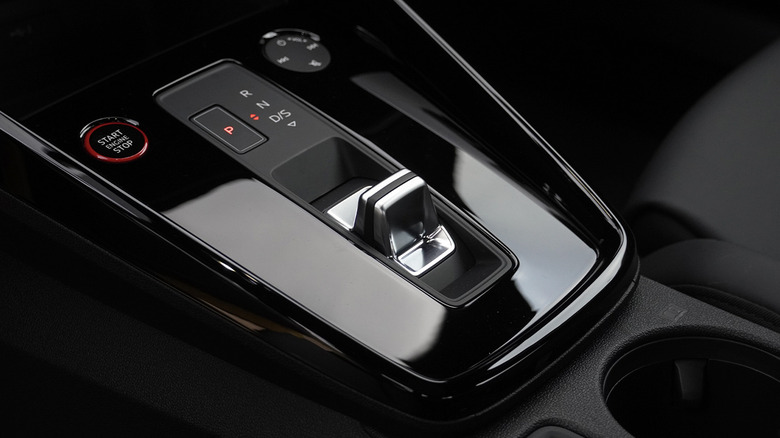
Michael Teo Van Runkle/SlashGear
With enough time under my belt in similar cars, I figured I might just stomp through some quick transitions as soon as possible. Right out of the gate, the RS3 now went full squirrel, all squiggly sideways shenanigans as the torque built, the rear wheels snapped around, and I countersteered through easily controlled slides while manically (or maniacally) grinning ear-to-ear nonstop. No, we’re not in Torsen diff land, but Audi 100% solved the inherent problem created by a transverse front-mounted engine layout and modern electronic drivetrain programming.
That rear diff, same as the Volkswagen Golf R sibling’s and similar to the Ford Focus RS (and, actually, the new Chevrolet Traverse Z71, out of absolute left field), uses twin clutches to send power to spinning wheel(s). All of a sudden, the RS3 transforms entirely, able to find the limit of traction and then progressively step further into the realm of tomfoolery. Cold Bridgestone Potenza Sport tires on a cold and wet day probably helped, but now, finally, this nose-heavy four-door truly delivers the rally racer experience, with a level of ease and confidence never before seen in any Audi I ever drove previously.
The RS3 will grow on you
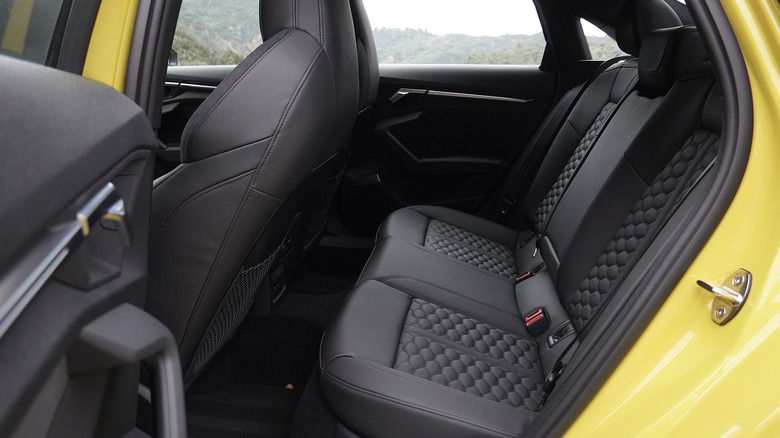
Michael Teo Van Runkle/SlashGear
Actually, the worst part now becomes how much I lust for an RS3. Is this my perfect daily driver, a one-car solution that can do everything I want in a car with ease? In a different color, of course, but just maybe. Even where I typically advocate for smaller wheels and taller tires to smooth out the ride, the adjustable dampers here work perfectly on every road condition I encountered—despite the 3,639-pound curb weight, no less. I nearly die in earnest daydreaming, desperate to drive the RS3 at top speed down a dirt road with knobby tires, or in some snow on true winter rubber.
I even found myself loving that thin steering wheel rim, and can appreciate that the minimalist shifter and center console combine to create plenty of knee room up front. With the rear seats folded down, the RS3 might even offer enough space for a bicycle, certainly some skis over the front armrest. Sure, the backseat itself still lacks the true leg or headroom for fully grown adults on a long road trip, but the shorter wheelbase and diminutive footprint of the RS3 seems a reasonable trade-off.
2024 Audi RS3 Verdict
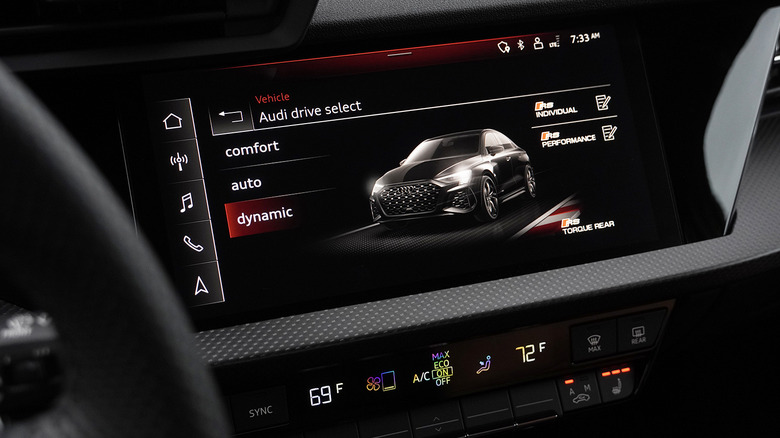
Michael Teo Van Runkle/SlashGear
That goes doubly when you consider sport sedans in this performance realm typically take up much more space on the road and in garages: think of the gargantuan four-door M3, Cadillac’s Blackwings, or an Alfa Romeo Giulia Quadrifoglio. Even if the RS3 tips the scales in a similar ballpark, the sheer size makes for the nearest thing to a rally car on the market right now, since the Mitsubishi Lancer Evo and Subaru STI both went extinct.
Maybe the only car that might compare, the sublime Hyundai Ioniq 5 N, lacks the character of a true internal-combustion engine. That’s not necessarily the worst thing, and the I5N is undeniably spectacular with the fake noises turned off. For the dual requirements of performance driving and road-tripping alike, though, I still lean toward internal-combustion without hesitation.
But then I start to fret that the RS3 is not available with a good-old-fashioned stick shift and clutch pedal. (Such a shame—truly, almost worth swapping in a manual gearbox from a Golf R.) And the price tag, at $61,700 to start or $67,990 as optioned with the Technology and Optic Plus packages making up the big-ticket items, almost doubles my old A3 2.0T. Then again, in today’s market, a Honda Civic can cost upward of 50 grand, and in comparison to either the Civic Type R or Integra Type S in a similar bracket, or the BMW and Alfa one step further up the price ladder, the Audi RS3 absolutely seems worth every penny.